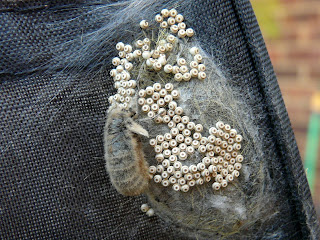 This is where the story starts to get really interesting. On the 18th September I came home from work and glanced at the cocoon as I walked through the garage, and did not see anything interesting. I started working in the garden as one does with the front and rear garage doors open. A short time afterwards I passed through the garage again and this time noticed a male Vapourer Moth sitting exactly where the cocoon was. I couldn't believe my eyes, and at first felt gutted that I had missed an actual hatching of a moth from a pupa. I went to fetch my camera, and on returning found that the male Vapourer had flown. However, this time on closer inspection I noticed that on top of the cocoon was what looked like some sort of bug. After consulting the bible "Field Guide to the Moths of Great Britain and Ireland", I could see that it was a female Vapourer Moth that had hatched from the pupa, and not a male as first thought. The female had given off such a strong pheromone that she had attracted a male from inside the garage. Whether it was our male that hatched on the 11th September we will never know. Below is the picture of the female taken at 15:44.
This is where the story starts to get really interesting. On the 18th September I came home from work and glanced at the cocoon as I walked through the garage, and did not see anything interesting. I started working in the garden as one does with the front and rear garage doors open. A short time afterwards I passed through the garage again and this time noticed a male Vapourer Moth sitting exactly where the cocoon was. I couldn't believe my eyes, and at first felt gutted that I had missed an actual hatching of a moth from a pupa. I went to fetch my camera, and on returning found that the male Vapourer had flown. However, this time on closer inspection I noticed that on top of the cocoon was what looked like some sort of bug. After consulting the bible "Field Guide to the Moths of Great Britain and Ireland", I could see that it was a female Vapourer Moth that had hatched from the pupa, and not a male as first thought. The female had given off such a strong pheromone that she had attracted a male from inside the garage. Whether it was our male that hatched on the 11th September we will never know. Below is the picture of the female taken at 15:44.
 Within minutes of the mating, the female Vapourer began laying eggs as the photograph below shows taken at 16:19. She had already laid 10 eggs at this stage.
Within minutes of the mating, the female Vapourer began laying eggs as the photograph below shows taken at 16:19. She had already laid 10 eggs at this stage.
 The rate at which she was producing these eggs was phenomenal as can be seen from the next photo taken at 17:00.
The rate at which she was producing these eggs was phenomenal as can be seen from the next photo taken at 17:00. From the final photo, taken on the 24th Sept at 07:42, there appear to be approx. 180 eggs. You are welcome to count them! The already mentioned field guide indicates that she would lay several hundred. After this the unfortunate Moth dies, as mine certainly did. Remember this Moth hatched from its pupa, remained on its cocoon, mated almost instantly, and then started to lay eggs on its cocoon. During this time it did not eat or drink. What a remarkable Moth!
From the final photo, taken on the 24th Sept at 07:42, there appear to be approx. 180 eggs. You are welcome to count them! The already mentioned field guide indicates that she would lay several hundred. After this the unfortunate Moth dies, as mine certainly did. Remember this Moth hatched from its pupa, remained on its cocoon, mated almost instantly, and then started to lay eggs on its cocoon. During this time it did not eat or drink. What a remarkable Moth! These eggs will now overwinter and then hatch into larvae from May onwards next year. I must now work out how to transfer the eggs from the outside of the rearing tent onto the Pyracantha bush to ensure a healthy population next year. If anyone has any ideas then please let me know.
These eggs will now overwinter and then hatch into larvae from May onwards next year. I must now work out how to transfer the eggs from the outside of the rearing tent onto the Pyracantha bush to ensure a healthy population next year. If anyone has any ideas then please let me know.
 Meanwhile, on the 11th September, the small unknown pupa hatched out into the beautiful male Vapourer Moth as shown below. I was unable to get a really good photograph as it quickly flew away once outside the rearing tent.
Meanwhile, on the 11th September, the small unknown pupa hatched out into the beautiful male Vapourer Moth as shown below. I was unable to get a really good photograph as it quickly flew away once outside the rearing tent.






0 Comments:
Post a Comment
<< Home